Exploration of Alternatives to Reduce the Gap in Access to Electricity in Rural Communities—Las Nubes Village Case (Barranquilla, Colombia)
Abstract
1. Introduction
- It establishes an explicit connection between the metrics commonly used in HRES modeling with SDG 7 indicators.
- It takes into account the current economic activity of the community as the main source for energy generation complemented by other renewable sources.
2. Materials and Methods
- The first step was to load the data for a Typical Meteorological Year (TMY) for the study location as well as the minimum and maximum hourly values of daily electricity demand. The TMY data were downloaded from PVWatts Calculator® https://pvwatts.nrel.gov/pvwatts.php (accessed on 19 July 2023). Particularly, wind speed at 10 m (corrected to 50 m) and beam irradiance were useful for this research. The demand data correspond with a low social class extracted from a characterization of the load profile according to socioeconomic stratification in the city of Barranquilla [41] but adapted to the locality of interest according to a set of assumptions described in the results section.
- The second step was to calculate the energy produced by the biomass. We assumed a constant supply of electricity from biomass every hour. The procedure for estimating the production of biogas from the volatile solid content was as follows:
- The animal mass was determined, given by Equation (1), where is the number of pigs of small size , medium size , and large size . is the average weight per each size of pig.
- The number of average animal units was calculated considering that, for pigs, . In other words,
- Each animal unit () generates approximately 19 tons of swine manure per year so the amount of total swine manure was:
- Swine manure has approximately 6% dry matter and between 70% and 80% volatile solids . Hence, the total of volatile solids in the swine manure was:
- Each kilogram of volatile solids generates up to 300 L of biogas, with 60% methane content so the amount of biogas B that can be obtained from SV is:
- The amount of energy produced from biogas , considering its minimum energy content of , was:
- Equation (7) gave the capacity of the electricity-generating unit GUC for a generating unit efficiency of 30% and an annual operating time h:
- The third step consisted of building an annual unsatisfied electricity demand (the demand not covered by biomass) curve using simulation. In each iteration, random values of hourly demand were taken between the minimum and maximum values of each hour of the daily demand curve. The procedure was performed a thousand times, resulting in a normal probability distribution for the annual demand. The biomass power generation (of assumed constant capacity) was subtracted from the mean of the distribution, keeping the same variance. Thus, the demand curve not covered by biomass energy production was obtained.
- The fourth step consisted of determining the combinations of solar panels and wind turbines needed to cover the unsatisfied electricity demand. If is the fraction to be covered by panels, and the fraction to be covered by turbines, with , the number of panels and the number of turbines needed to cover the deficit were calculated according to the following equations:
- 5.
- The fifth step was the simulation of each hybrid system. The TMY data contain the annual hourly estimate of irradiance and wind speed for the location of interest. These hourly data, grouped by month, were taken as initial samples to generate random data for these variables using bootstrapping. The amount of hourly energy produced by each hybrid system was estimated using the equation:
System Optimization Model
3. Results
- The community uses an isolated hybrid system, that is, there is no connection to the grid, and it has batteries to store any surplus.
- The community is not connected to the grid and the deficit is covered using a diesel-based generation system.
- Finally, the community is connected to the grid and is allowed to send its surpluses to the grid.
4. Discussion
5. Conclusions
Author Contributions
Funding
Data Availability Statement
Acknowledgments
Conflicts of Interest
Nomenclature
| List of Abbreviations | |
| ACS: annualized cost [$/year] | LCOE: levelized cost of energy [$/kWh] |
| AEFA: artificial electric field algorithm | LPSP: loss of power supply probability |
| BAT: battery | MDVP: movable damped wave algorithm |
| BM: biomass | MHP: micro-hydro power |
| CEQ: carbon emission quantity | MOGA: multi-objective genetic algorithm |
| COE: cost of the energy | NPC: Net present cost |
| DE: differential evolution algorithm | NSGA II: non-dominated sorting genetic algorithm II |
| DG: diesel generator | PHS: pumped-hydro storage |
| DPSP: deficiency of power supply probability | PSO: particle swarm optimization |
| EFF: excess energy fraction | PMBSA: Pareto multi-objective backtrack search algorithm |
| FF: firefly algorithm | SOA: seagull optimization algorithm |
| GA: genetic algorithm | SDG: UN Sustainable Development Goals |
| GUC: capacity of the electricity generating unit | SMA: slime mould algorithm (SMA) |
| GWO: gray wolf algorithm | SPV: solar photovoltaic system |
| HHO: Harris hawks optimization | QRUN: quantum Runge–Kutta |
| HOMER: Hybrid Optimization of Multiple Energy Resources | TC: total cost |
| HS: harmony search | TMY: Typical Meteorological Year |
| HRES: hybrid renewable energy systems | W: wind |
| WOA: whale optimization algorithm | |
| List of Symbols | |
| AFS: annual full solar hours | : hourly energy produced by a hybrid system [kWh] |
| B: amount of biogas [m3/day] | : livestock mass [kg] |
| battery nominal capacity [Ah] | : minimum energy content on biogas [kWh/m3] |
| : total costs associated with biomass [$] | : project lifetime [year] |
| CI: unit investment costs [$] | : numbers of batteries |
| : total investment cost [$] | : numbers of panels |
| : the annual fuel cost [$] | : numbers of wind turbines |
| : total annual operation and maintenance cost [$/year] | : number of pigs |
| : unit annual operation and maintenance costs [$/year] | : numbers of inverters |
| : unit replacement cost [$] | : monthly energy generated from biomass [kWh] |
| : depth of discharge of the batteries [%] | : average weight of pig [kg] |
| : amount of swine manure [ton/year] | : panel unit power [W] |
| : biogas annual energy [kWh/year] | : wind turbine unit power [W] |
| : annual energy production [kWh/year] | : interest rate |
| : unit annual energy of wind turbine [kWh/year] | volatile solids [ton/year] |
| : energy fraction covered by panels | : average animal units |
| GUC: capacity bigas generating unit [kW] | : batteries operating voltage [V] |
| : hourly irradiance [kW/m2] | η: panel efficiency |
| : monthly energy deficit in month [kWh] |
References
- UN. The Sustainable Development Goals Report 2022. Available online: https://unstats.un.org/sdgs/report/2022 (accessed on 13 July 2023).
- UN. End Poverty in All Its Forms Everywhere. Available online: https://unstats.un.org/sdgs/report/2022/Goal-01/ (accessed on 15 July 2023).
- UN. Ensure Access to Affordable, Reliable, Sustainable and Modern Energy for All. Available online: https://unstats.un.org/sdgs/report/2022/Goal-07/ (accessed on 15 July 2023).
- Natividad, L.E.; Benalcazar, P. Hybrid Renewable Energy Systems for Sustainable Rural Development: Perspectives and Challenges in Energy Systems Modeling. Energies 2023, 16, 1328. [Google Scholar] [CrossRef]
- He, J.; Wu, Y.; Wu, J.; Li, S.; Liu, F.; Zhou, J.; Liao, M. Towards cleaner heating production in rural areas: Identifying optimal regional renewable systems with a case in Ningxia, China. Sustain. Cities Soc. 2021, 75, 103288. [Google Scholar] [CrossRef]
- Villavicencio Calzadilla, P.; Mauger, R. The UN’s new sustainable development agenda and renewable energy: The challenge to reach SDG7 while achieving energy justice. J. Energy Nat. Resour. Law 2018, 36, 233–254. [Google Scholar] [CrossRef]
- Kumar, N.M.; Chopra, S.S.; Chand, A.A.; Elavarasan, R.M.; Shafiullah, G. Hybrid Renewable Energy Microgrid for a Residential Community: A Techno-Economic and Environmental Perspective in the Context of the SDG7. Sustainability 2020, 12, 3944. [Google Scholar] [CrossRef]
- Frilingou, N.; Xexakis, G.; Koasidis, K.; Nikas, A.; Campagnolo, L.; Delpiazzo, E.; Chiodi, A.; Gargiulo, M.; McWilliams, B.; Koutsellis, T.; et al. Navigating through an energy crisis: Challenges and progress towards electricity decarbonisation, reliability, and affordability in Italy. Energy Res. Soc. Sci. 2023, 96, 102934. [Google Scholar] [CrossRef]
- Gul, E.; Baldinelli, G.; Bartocci, P.; Shamim, T.; Domenighini, P.; Cotana, F.; Wang, J.; Fantozzi, F.; Bianchi, F. Transition toward net zero emissions—Integration and optimization of renewable energy sources: Solar, hydro, and biomass with the local grid station in central Italy. Renew. Energy 2023, 207, 672–686. [Google Scholar] [CrossRef]
- Mahdavi, M.; Jurado, F.; Ramos, R.A.V.; Awaafo, A. Hybrid biomass, solar and wind electricity generation in rural areas of Fez-Meknes region in Morocco considering water consumption of animals and anaerobic digester. Appl. Energy 2023, 343, 121253. [Google Scholar] [CrossRef]
- Guzman, L.; Henao, A. Are the current incentives sufficient to drive the use of solar PV in the Colombian residential sector?—An analysis from the perspective of the game theory. Energy Strat. Rev. 2022, 40, 100816. [Google Scholar] [CrossRef]
- Amini, S.; Bahramara, S.; Golpîra, H.; Francois, B.; Soares, J. Techno-Economic Analysis of Renewable-Energy-Based Micro-Grids Considering Incentive Policies. Energies 2022, 15, 8285. [Google Scholar] [CrossRef]
- Trinh, V.; Chung, C. Renewable energy for SDG-7 and sustainable electrical production, integration, industrial application, and globalization: Review. Clean. Eng. Technol. 2023, 15, 100657. [Google Scholar] [CrossRef]
- Kamal, M.; Ashraf, I.; Fernandez, E. Optimal sizing of standalone rural microgrid for sustainable electrification with renewable energy resources. Sustain. Cities Soc. 2023, 88, 104298. [Google Scholar] [CrossRef]
- Prakash, S.V.J.; Dhal, P. Cost optimization and optimal sizing of standalone biomass/diesel generator/wind turbine/solar microgrid system. AIMS Energy 2022, 10, 665–694. [Google Scholar] [CrossRef]
- Jahangir, M.H.; Bazdar, E.; Kargarzadeh, A. Techno-economic and environmental assessment of low carbon hybrid renewable electric systems for urban energy planning: Tehran-Iran. City Environ. Interact. 2022, 16, 100085. [Google Scholar] [CrossRef]
- Kharrich, M.; Kamel, S.; Abdel-Akher, M.; Eid, A.; Zawbaa, H.M.; Kim, J. Optimization based on movable damped wave algorithm for design of photovoltaic/ wind/ diesel/ biomass/ battery hybrid energy systems. Energy Rep. 2022, 8, 11478–11491. [Google Scholar] [CrossRef]
- Heydaria, A.; Alborzib, Z.S.; Amini, Y.; Hassanvand, A. Configuration optimization of a renewable hybrid system including biogas generator, photovoltaic panel and wind turbine: Particle swarm optimization and genetic algorithms. Int. J. Mod. Phys. C 2022, 34, 3500699. [Google Scholar] [CrossRef]
- Mahmoud, F.S.; Diab, A.A.Z.; Ali, Z.M.; El-Sayed, A.-H.M.; Alquthami, T.; Ahmed, M.; Ramadan, H.A. Optimal sizing of smart hybrid renewable energy system using different optimization algorithms. Energy Rep. 2022, 8, 4935–4956. [Google Scholar] [CrossRef]
- El-Sattar, H.A.; Kamel, S.; Hassan, M.H.; Jurado, F. Optimal sizing of an off-grid hybrid photovoltaic/biomass gasifier/battery system using a quantum model of Runge Kutta algorithm. Energy Convers. Manag. 2022, 258, 115539. [Google Scholar] [CrossRef]
- El-Sattar, H.A.; Sultan, H.M.; Kamel, S.; Khurshaid, T.; Rahmann, C. Optimal design of stand-alone hybrid PV/wind/biomass/battery energy storage system in Abu-Monqar, Egypt. J. Energy Storage 2021, 44, 103336. [Google Scholar] [CrossRef]
- Gamil, M.M.; Lotfy, M.E.; Hemeida, A.M.; Mandal, P.; Takahashi, H.; Senjyu, T.; Co, L.F.E. Optimal sizing of a residential microgrid in Egypt under deterministic and stochastic conditions with PV/WG/Biomass Energy integration. AIMS Energy 2021, 9, 483–515. [Google Scholar] [CrossRef]
- Patibandla, A.; Kollu, R.; Rayapudi, S.R.; Manyala, R.R. A multi-objective approach for the optimal design of a standalone hybrid renewable energy system. Int. J. Energy Res. 2021, 45, 18121–18148. [Google Scholar] [CrossRef]
- Alturki, F.A.; Awwad, E.M. Sizing and Cost Minimization of Standalone Hybrid WT/PV/Biomass/Pump-Hydro Storage-Based Energy Systems. Energies 2021, 14, 489. [Google Scholar] [CrossRef]
- Suman, G.K.; Guerrero, J.M.; Roy, O.P. Optimisation of solar/wind/bio-generator/diesel/battery based microgrids for rural areas: A PSO-GWO approach. Sustain. Cities Soc. 2021, 67, 102723. [Google Scholar] [CrossRef]
- Jahangir, M.H.; Cheraghi, R. Economic and environmental assessment of solar-wind-biomass hybrid renewable energy system supplying rural settlement load. Sustain. Energy Technol. Assess. 2020, 42, 100895. [Google Scholar] [CrossRef]
- Li, J.; Liu, P.; Li, Z. Optimal design and techno-economic analysis of a solar-wind-biomass off-grid hybrid power system for remote rural electrification: A case study of west China. Energy 2020, 208, 118387. [Google Scholar] [CrossRef]
- Murugaperumal, K.; Srinivasn, S.; Prasad, G.S. Optimum design of hybrid renewable energy system through load forecasting and different operating strategies for rural electrification. Sustain. Energy Technol. Assess. 2019, 37, 100613. [Google Scholar] [CrossRef]
- Alshammari, N.; Asumadu, J. Optimum unit sizing of hybrid renewable energy system utilizing harmony search, Jaya and particle swarm optimization algorithms. Sustain. Cities Soc. 2020, 60, 102255. [Google Scholar] [CrossRef]
- Rehmani, A.M.; Akhter, P. Techno-Economic analysis of hybrid renewable energy systems for rural area energization in Pakistan. In Proceedings of the 2019 3rd International Conference on Energy Conservation and Efficiency (ICECE), Lahore, Pakistan, 23–24 October 2019. [Google Scholar]
- Ahmad, J.; Imran, M.; Khalid, A.; Iqbal, W.; Ashraf, S.R.; Adnan, M.; Ali, S.F.; Khokhar, K.S. Techno economic analysis of a wind-photovoltaic-biomass hybrid renewable energy system for rural electrification: A case study of Kallar Kahar. Energy 2018, 148, 208–234. [Google Scholar] [CrossRef]
- Ali, S.H.; Zuberi, M.J.S.; Tariq, M.A.; Baker, D.; Mohiuddin, A. A study to incorporate renewable energy technologies into the power portfolio of Karachi, Pakistan. Renew. Sustain. Energy Rev. 2015, 47, 14–22. [Google Scholar] [CrossRef]
- Lian, J.; Zhang, Y.; Ma, C.; Yang, Y.; Chaima, E. A review on recent sizing methodologies of hybrid renewable energy systems. Energy Convers. Manag. 2019, 199, 112027. [Google Scholar] [CrossRef]
- Bhatti, H.J.; Danilovic, M. Making the world more sustainable: Enabling localized energy generation and distribution on decentralized smart grid systems. World J. Eng. Technol. 2018, 06, 350–382. [Google Scholar] [CrossRef]
- Kalra, M.; Tyagi, S.; Kumar, V.; Kaur, M.; Mashwani, W.K.; Shah, H.; Shah, K. A Comprehensive Review on Scatter Search: Techniques, Applications, and Challenges. Math. Probl. Eng. 2021, 2021, 5588486. [Google Scholar] [CrossRef]
- Wickham, H.; Bryan, J. readxl: Read Excel Files—R Package Version 1.4.0. 2022. Available online: https://CRAN.R-project.org/package=readxl (accessed on 29 August 2023).
- Wickham, H.; Francois, R.; Henry, L.; Müller, K. dplyr: A Grammar of Data—Manipulation. R Package Version 1.0.8. 2022. Available online: https://CRAN.R-project.org/package=dplyr (accessed on 29 August 2023).
- Gross, J.; Ligges, U. nortest: Tests for Normality. R Package Version 1.0-4. 2015. Available online: https://CRAN.R-project.org/package=nortest (accessed on 29 August 2023).
- Schauberger, P.; Walker, A. openxlsx: Read, Write and Edit xlsx Files. R Package Version 4.2.5.2. 2023. Available online: https://CRAN.R-project.org/package=openxlsx (accessed on 29 August 2023).
- Wickham, H. ggplot2: Elegant Graphics for Data Analysis; Springer: New York, NY, USA, 2016. [Google Scholar]
- Pinedo, R.D.Y.; Pérez, A.A.H.; Ocampo, M.C.E.; Ahumada, D.E.M.; González, V.P.Q. ANÁLISIS DEL PERFIL DE CARGA ELÉCTRICA POR ESTRATO EN LA CIUDAD DE BARRANQUILLA. 2018. Available online: http://hdl.handle.net/10584/8312 (accessed on 29 August 2023).
- Acuña, L.G.; Padilla, R.V.; Mercado, A.S. Measuring reliability of hybrid photovoltaic-wind energy systems: A new indicator. Renew. Energy 2017, 106, 68–77. [Google Scholar] [CrossRef]
- World Bank. State of Electricity Access Report (SEAR) 2017. Available online: https://www.worldbank.org/en/topic/energy/publication/sear (accessed on 16 August 2023).
- Martinot, E.; Chaurey, A.; Lew, D.; Moreira, J.R.; Wamukonya, N. Renewable energy markets in developing countries. Annu. Rev. Energy Environ. 2002, 27, 309–348. [Google Scholar] [CrossRef]

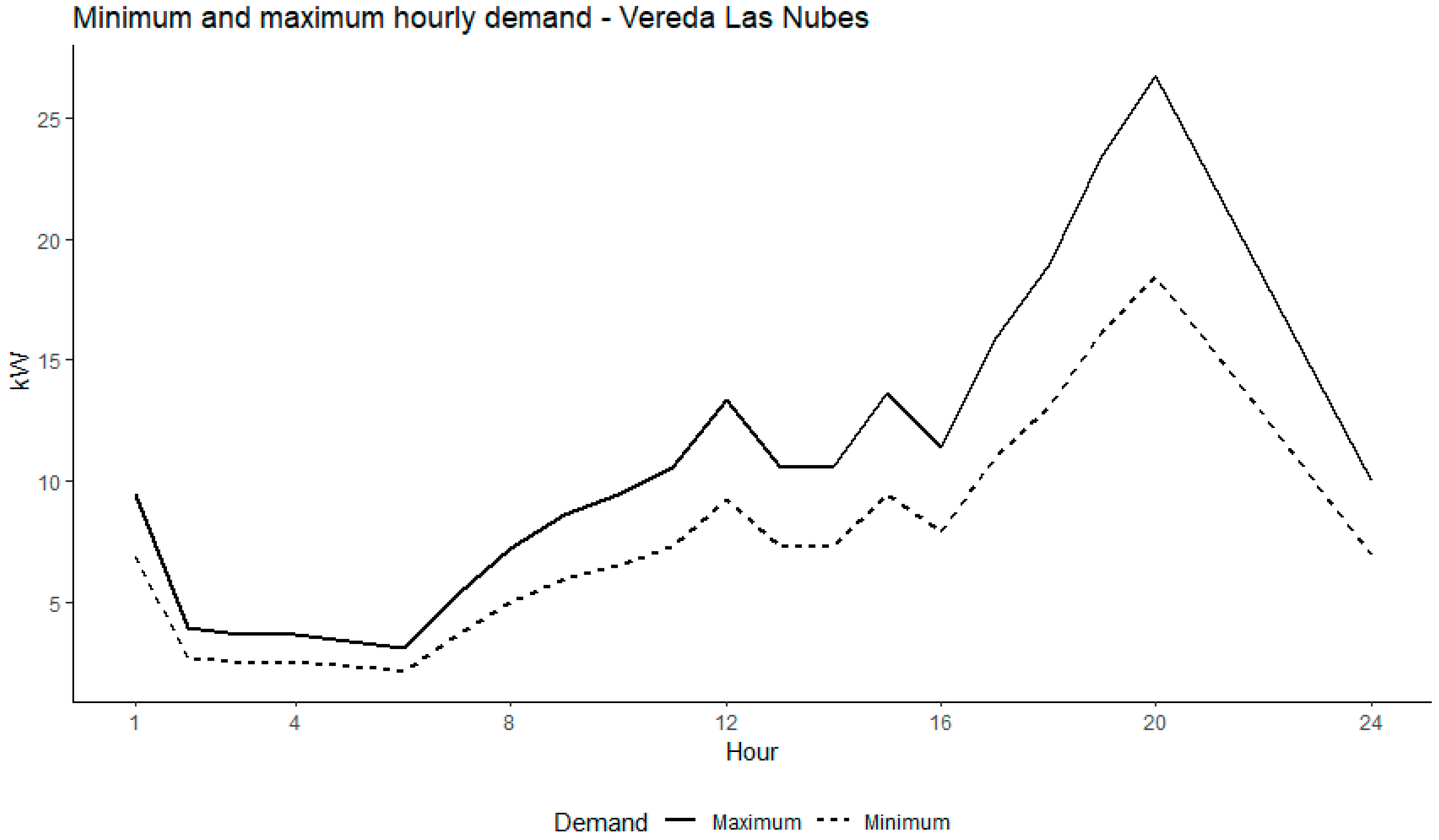

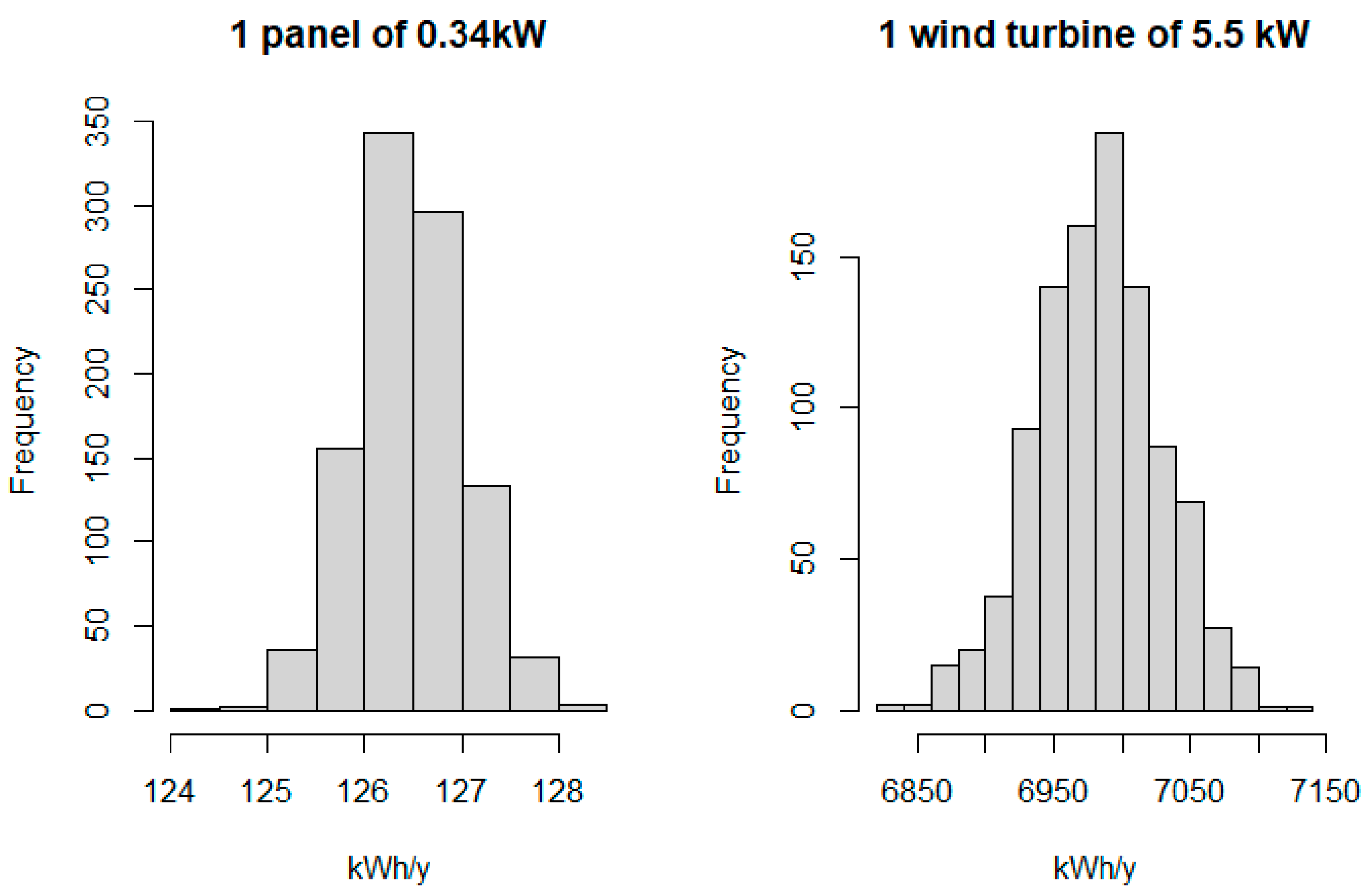
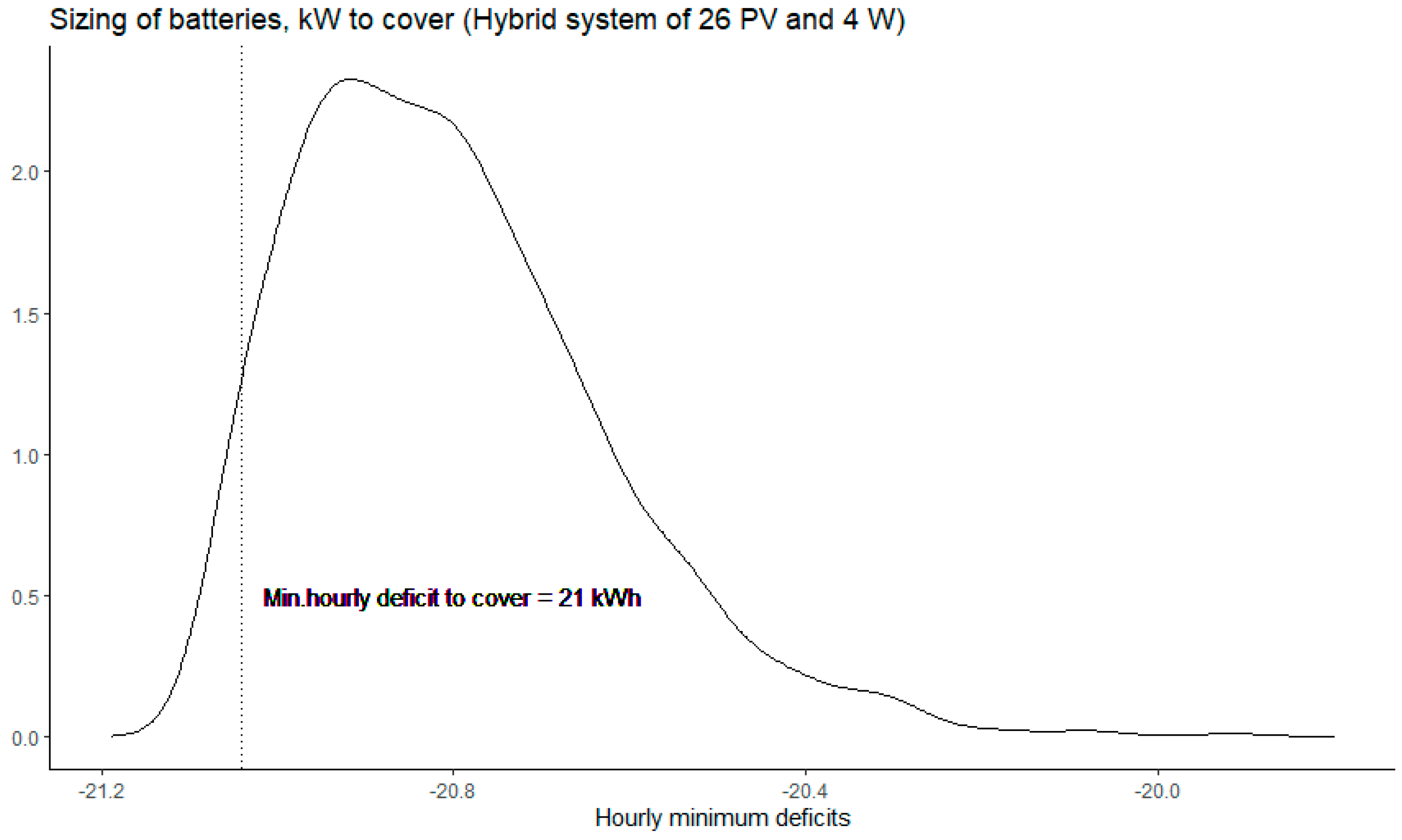
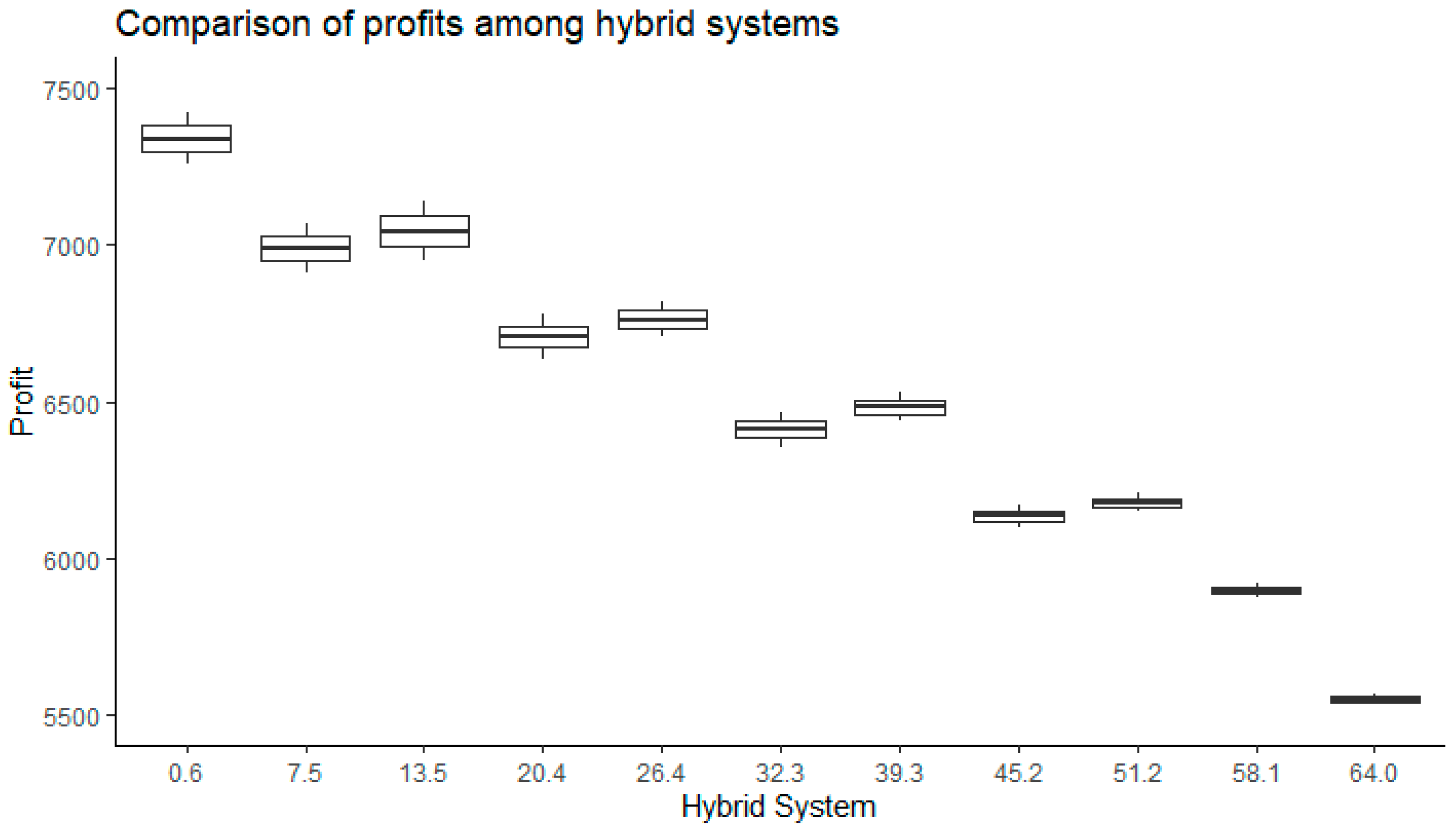
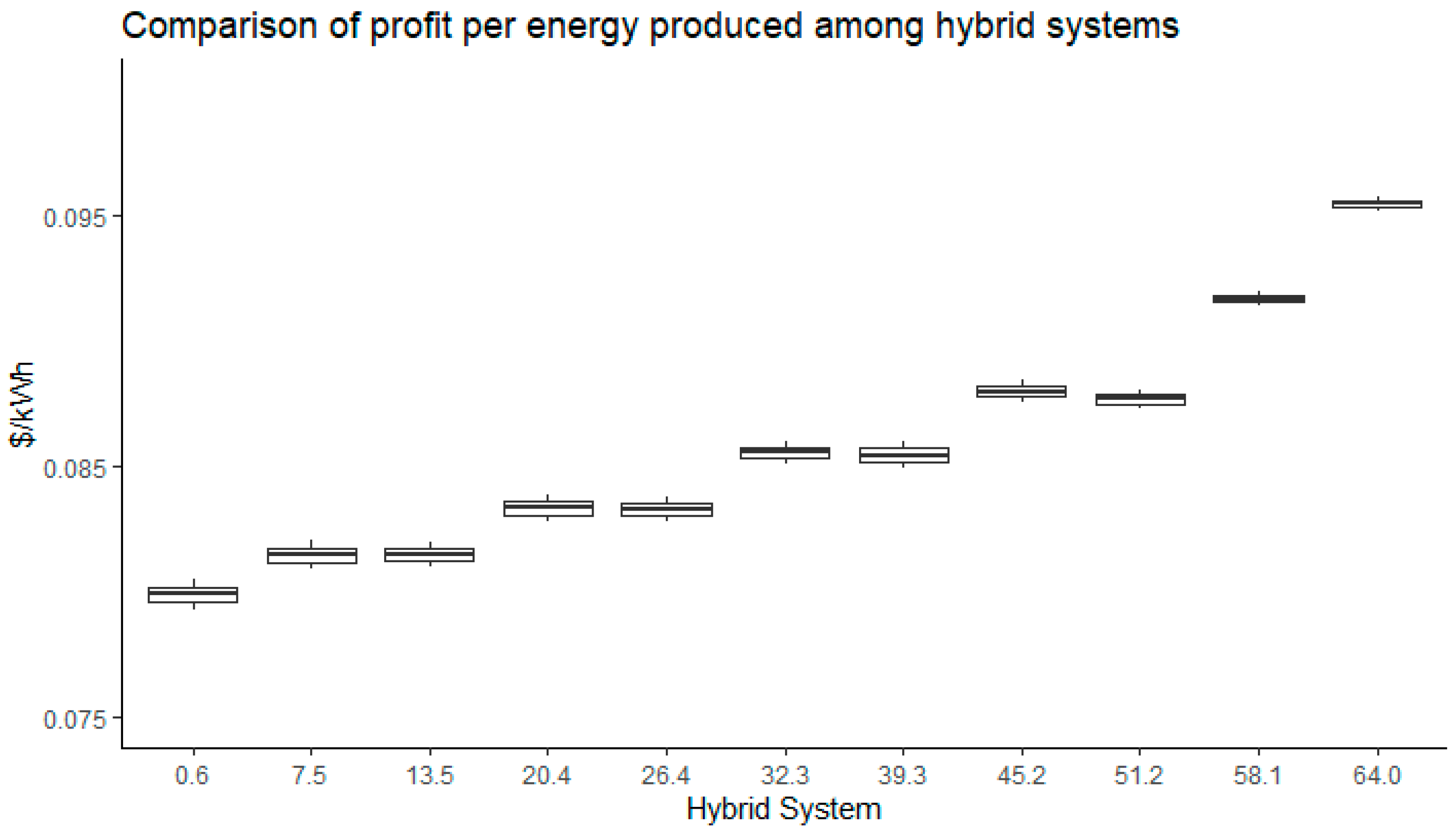

| Reference | Location | Methods/Software Tool | Evaluation Criteria | Additional Components | Summary |
|---|---|---|---|---|---|
| [14] | India | DE-MATLAB | NPC | MHP BAT | The authors dimensioned an isolated system based on renewable resources in the area. Comparison with PSO and GA. Sensitivity analysis with costs and input parameters. |
| [15] | India | HOMER | NPC | DG | Analysis of several configurations; the best was PV/BM/DG. The authors sought to reduce pollution and minimize NPCs. |
| [16] | Iran | HOMER | NPC, COE, CEQ | BAT | Analysis of seven systems; the best one was PV/BM/DG. |
| [17] | Saudi Arabia | MDVP | NPC | BAT DG | Analysis of four configurations; the best one was PV/BM. They compared the algorithms AEFA, HHO, GWO, and MDVP. IN conclusion, MDVP was the best. |
| [18] | Iran | GA, PSO | NPC | The authors considered the rare PV/W/BM. The PV/biomass system was the most cost-effective. They compared GA and PSO. | |
| [19] | Afghanistan | HOMER | NPC | DG | The most optimal solution for 300 families was PV/BM/DG. |
| [20] | Egypt | QRUN | COE | They analyzed the superiority of the QRUN algorithm with respect to other solution algorithms. | |
| [21] | Egypt | SMA, SOA, GWO, SCA | COE | BAT | Analysis of three configurations; the best was W/BM/BAT. Comparison of the algorithms; the best was SMA. |
| [22] | Egypt | MOGA | TC | BAT | They used Monte Carlo simulations to simulate solar radiation and wind speed. They considered six systems; the best was solar PV. They used rice straw as the biomass. |
| [23] | India | PMBSA | TC, LPSP | BAT DG | Weibull distribution models for wind and solar radiation. Normal distribution models for load demand. They analyzed two scenarios: with and without biomass. The first was better. |
| [24] | Saudi-Arabia | WOA, FF, PSO | COE | PHS BAT | Two configurations were considered. The best was W/PV/BM/PHS. |
| [25] | India | PSO, GWO | COE, DPSP | The performance of the algorithm was compared with others under different scenarios in three places. | |
| [26] | Iran | HOMER | COE | BAT | The economic system was BM/PV/BAT. CO2 decreased significantly. |
| [27] | China | HOMER | TC | BAT | The sensitivity analysis indicated the PV/wind/BDG/battery model was more economically viable than grid extension. |
| [28] | India | HOMER | ACS | BAT | Different operational strategies were compared. PV/W/BM/was the best configuration. |
| [29] | PSO, HS, Jaya | LPSP, EFF | BAT | Different configurations were modeled, simulated, and optimized. The best system was PV/W/BM/BAT. | |
| [30] | Pakistan | HOMER | NPC | Four configurations were modeled; the best was PV/BM. | |
| [31] | Pakistan | HOMER | NPC | Wind power was modeled with Weibull distribution. The biomass was dung cow manure. The grid-connected hybrid system proved to be more cost-efficient. | |
| [32] | Pakistan | LCOE, NPV | The authors calculated the potential of solar, wind, and biomass energy to build a portfolio that supplied 10% of Karachi’s peak demand. |
| Plot | 1 | 2 | 3 | 4 | 5 | 6 | 7 | 8 | 9 | 10 | Total |
|---|---|---|---|---|---|---|---|---|---|---|---|
| Number of houses | 4 | 2 | 2 | 2 | 2 | 2 | 1 | 4 | 2 | 3 | 24 |
| Number of inhabitants | 12 | 12 | 6 | 5 | 6 | 3 | 13 | 12 | 10 | 18 | 97 |
| Pig Size | Plot Number of Pigs | , kg | Average Excreta, kg | Total Excreta, kg | |||||||
|---|---|---|---|---|---|---|---|---|---|---|---|
| 1 | 2 | 3 | 4 | 5 | 6 | 7 | |||||
| Large | 8 | 10 | 2 | 6 | 2 | 21 | 2 | 51 | 60 | 3 | 153 |
| Medium | 42 | 27 | 0 | 10 | 0 | 80 | 36 | 195 | 25 | 2.5 | 487.5 |
| Small | 10 | 43 | 14 | 10 | 5 | 26 | 10 | 118 | 15 | 1.5 | 177 |
| Total | 364 | 817.5 | |||||||||
| Parameter | Value |
|---|---|
| Maximum power (biogas) | 5000 W |
| Frequency | 50 Hk/60 Hz |
| Nominal voltage | 400 V/300 V |
| Nominal current [A] | 8.3 |
| Velocity | 1500 rpm/1800 rpm |
| Engine oil capacity [l] | 0.55 |
| Gas consumption [m3/h] | 1.4 |
| Useful life [years] | 20 |
| Parameter | Value |
|---|---|
| Maximum power [W] | 340 |
| Maximum voltage [V] | 38.5 |
| Maximum current [A] | 8.84 |
| Open circuit voltage [V] | 46.4 |
| Short circuit current [A] | 9.45 |
| Temperature coefficient of open circuit voltage [%/°C] | −0.29506 |
| Temperature coefficient of short circuit current [%/°C] | 0.08558 |
| Normal operating temperature [°C] | 40 |
| Efficiency [%] | 17.5 |
| Useful life [year] | 20 |
| Area [m2] | 1.94 |
| Number of PV panels (PV system) | 0 | 7 | 13 | 20 | 26 | 32 | 39 | 45 | 51 | 58 | 64 |
| Number of wind turbines (Wind system) | 6 | 5 | 5 | 4 | 4 | 3 | 3 | 2 | 2 | 1 | 0 |
| Parameter | Value |
|---|---|
| Nominal power [W] | 5500 |
| Sweep area [m2] | 145 |
| Cut-in wind speed [m/s], vc | 2 |
| Nominal speed [m/s], vr | 11 |
| Cut-out wind speed [m/s], vf | 12 |
| Useful life [years] | 20 |
| Costs | CI ($) | COM ($/year) | Crep ($) |
|---|---|---|---|
| Solar panel | 103.1 | 4.84 | 0 |
| Wind turbine | 7777.8 | 427.8 | 0 |
| Biodigester and components | 400 | 16 | 0 |
| Generating unit for biogas | 1000 | 40 | 0 |
| Inverter | 3013.3 | 30 | 136.4 |
| Battery | 179.7 | 8.9 | 8.1 |
| Diesel generator | 5555 | 650 | 0 |
| Diesel [$/L] 0.5 |
| LCOE_mean | |
|---|---|
| (0 − 6) | 0.110 |
| (7 − 5) | 0.103 |
| (13 − 5) | 0.104 |
| (20 − 4) | 0.096 |
| (26 − 4) | 0.097 |
| (32 − 3) | 0.088 |
| (39 − 3) | 0.089 |
| (45 − 2) | 0.079 |
| (51 − 2) | 0.079 |
| (58 − 1) | 0.068 |
| (64 − 0) | 0.054 |
| Agent | Cost [$] |
|---|---|
| Unit cost of service provision, $/kWh | |
| Commercialization cost, $/kWh | |
| Power exchange price, $/kWh |
Disclaimer/Publisher’s Note: The statements, opinions and data contained in all publications are solely those of the individual author(s) and contributor(s) and not of MDPI and/or the editor(s). MDPI and/or the editor(s) disclaim responsibility for any injury to people or property resulting from any ideas, methods, instructions or products referred to in the content. |
© 2024 by the authors. Licensee MDPI, Basel, Switzerland. This article is an open access article distributed under the terms and conditions of the Creative Commons Attribution (CC BY) license (https://creativecommons.org/licenses/by/4.0/).
Share and Cite
Henao, A.; Guzman, L. Exploration of Alternatives to Reduce the Gap in Access to Electricity in Rural Communities—Las Nubes Village Case (Barranquilla, Colombia). Energies 2024, 17, 256. https://doi.org/10.3390/en17010256
Henao A, Guzman L. Exploration of Alternatives to Reduce the Gap in Access to Electricity in Rural Communities—Las Nubes Village Case (Barranquilla, Colombia). Energies. 2024; 17(1):256. https://doi.org/10.3390/en17010256
Chicago/Turabian StyleHenao, Alvin, and Luceny Guzman. 2024. "Exploration of Alternatives to Reduce the Gap in Access to Electricity in Rural Communities—Las Nubes Village Case (Barranquilla, Colombia)" Energies 17, no. 1: 256. https://doi.org/10.3390/en17010256
APA StyleHenao, A., & Guzman, L. (2024). Exploration of Alternatives to Reduce the Gap in Access to Electricity in Rural Communities—Las Nubes Village Case (Barranquilla, Colombia). Energies, 17(1), 256. https://doi.org/10.3390/en17010256






